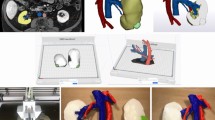Abstract
Purpose
To determine whether a 3D printed model improves patients’ understanding of renal cryoablation and the involved anatomy.
Methods
This prospective study included 25 control patients, who received standard of care renal cryoablation education (verbal explanation accompanied by review of relevant 2D imaging) and 25 experimental patients, who received education using a 3D printed renal cryoablation model in addition to standard of care. Subsequent patient surveys included 5 anatomy and 5 procedural knowledge questions. The experimental cohort also subjectively graded the importance of the 3D model for understanding the renal cryoablation procedure and associated anatomy.
Results
Mean percent of anatomy questions answered correctly was significantly higher in the experimental cohort than that in the control group (87.2% vs. 72.8%; p = 0.007). After adjusting for the physician providing the education, however, the 3D model was no longer significantly associated with patient anatomy knowledge (p = 0.22). Mean percent of procedure-related questions answered correctly was higher in the experimental cohort (93.6%) than that in the control group (89.6%) (p = 0.16). The experimental cohort graded the importance of the 3D model for understanding their renal tumor anatomy and upcoming procedure to be very high (mean 9.4 and 9.5, respectively, on a 0–10 point scale). Twenty-three (92%) patients “definitely recommended” continued use of the 3D model as a patient educational tool.
Conclusions
Although patients’ objective anatomy and procedural knowledge was not significantly improved with the 3D renal cryoablation model in this small pilot study, patients’ high perceived value of the model supports investigation in a larger study.


Similar content being viewed by others
References
Mehra P, Miner J, D’Innocenzo R, Nadershah M (2011) Use of 3-d stereolithography models in oral and maxillofacial surgery. J Maxillofac Oral Surg 10(1):6–13
Akiba T, Inagaki T, Nakada T (2014) Three dimensional printing of anomalous bronchi before surgery. Ann Thorac Cardiovasc Surg 20:659–662
Schmauss D, Schmitz C, Bigdeli AK, et al. (2012) Three-dimensional printing of models for preoperative planning and simulation of transcatheter valve replacement. Ann Thorac Surg 93:231–233
Starosolski ZA, Kan JH, Rosenfeld SD, et al. (2014) Application of 3-D printing (rapid prototyping) for creating physical models of pediatric orthopedic disorders. Pediatr Radiol 44(2):216–221
Ripley B, Kelil T, Cheezum MK, et al. (2016) 3D printing based on cardiac CT assists anatomic visualization prior to transcatheter aortic valve replacement. J Cardiovasc Comput Tomogr 10(1):28–36
Costello JP, Oliviere LJ, Su L, et al. (2015) Incorporating three-dimensional printing into a simulation-based congenital heart disease and critical care training curriculum for resident physicians. Congenit Heart Dis 10:185–190
Giannopoulos AA, Mitsouras D, Yoo S, et al. (2016) Applications of 3D printing in cardiovascular diseases. Nat Rev Cardiol 13:701–718
Marks M, Alexander A, Matsumoto J, et al. (2017) Creating three dimensional models of Alzheimer’s disease. 3D Print Med 3:13
Sandri G, Oderich G, Matsumoto J, et al. (2017) Prospective validation of high-fidelity simulation of endovascular aortic aneurysm repair using 3D printed aortic model and fluid pump. J Vasc Surg 65:1635–1636
Thompson RH, Atwell T, Schmit G, et al. (2015) Comparison of partial nephrectomy and percutaneous ablation for cT1 renal masses. Eur Urol 67(2):252–259
Aoun HD, Littrup PJ, Jaber M, et al. (2017) Percutaneous cryoablation of renal tumors: is it time for a paradigm shift? J Vasc Interv Radiol 28(10):1363–1370
Breen DL, Bryant TJ, Abbas A, et al. (2013) Percutaneous cryoablation of renal tumors: outcomes from 171 tumors in 147 patients. BJU Int 112(6):758–765
Georgiades CS, Rodriguez R (2014) Efficacy and safety of percutaneous cryoablation of stage 1A/B renal cell carcinoma: results of a prospective, single-arm, 5-year study. Cardiovasc Interv Radiol 37(6):1494–1499
Bernhard J, Isotani S, Matsugasumi T, et al. (2016) Personalized 3D printed model of kidney and tumor anatomy: a useful tool for patient education. World J Urol 34(3):337–345
Atalay HA, Canat HL, Ulker V, et al. (2017) Impact of personalized three dimensional -3D- printed pelvicalyceal system models on patient information in percutaneous nephrolithotripsy surgery: a pilot study. Int Braz J Urol 43(3):470–475
Biglino G, Capelli C, Wray J, et al. (2015) 3D-manufactured patient-specific models of congenital heart defects for communication in clinical practice: feasibility and acceptability. BMJ Open 5(4):e007165
Silberstein JL, Maddox MM, Dorsey P, et al. (2014) Physical models of renal malignancies using standard cross-sectional imaging and 3-dimensional printers: a pilot study. Urology 84(2):268–273
Schmocker RK, Cherney Stafford LM, Siy AB, Leverson GE, Winslow ER (2015) Understanding the determinants of patient satisfaction with surgical care using the Consumer Assessment of Healthcare Providers and Systems surgical care survey (S-CAHPS). Surgery 158(6):1724–1733
Prabhu KL, Cleghorn MC, Elnahas A, et al. (2018) Is quality important to our patients? The relationship between surgical outcomes and patient satisfaction. BMJ Qual Saf 27(1):48–52
Campbell S, Uzzo RG, Allaf ME, et al. (2017) Renal mass and localized renal cancer: AUA guideline. J Urol 198(3):520–529
Author information
Authors and Affiliations
Corresponding author
Ethics declarations
Disclosures
None for any authors.
Ethical approval
IRB approval was obtained for the study.
Rights and permissions
About this article
Cite this article
Schmit, C., Matsumoto, J., Yost, K. et al. Impact of a 3D printed model on patients’ understanding of renal cryoablation: a prospective pilot study. Abdom Radiol 44, 304–309 (2019). https://doi.org/10.1007/s00261-018-1710-1
Published:
Issue Date:
DOI: https://doi.org/10.1007/s00261-018-1710-1




